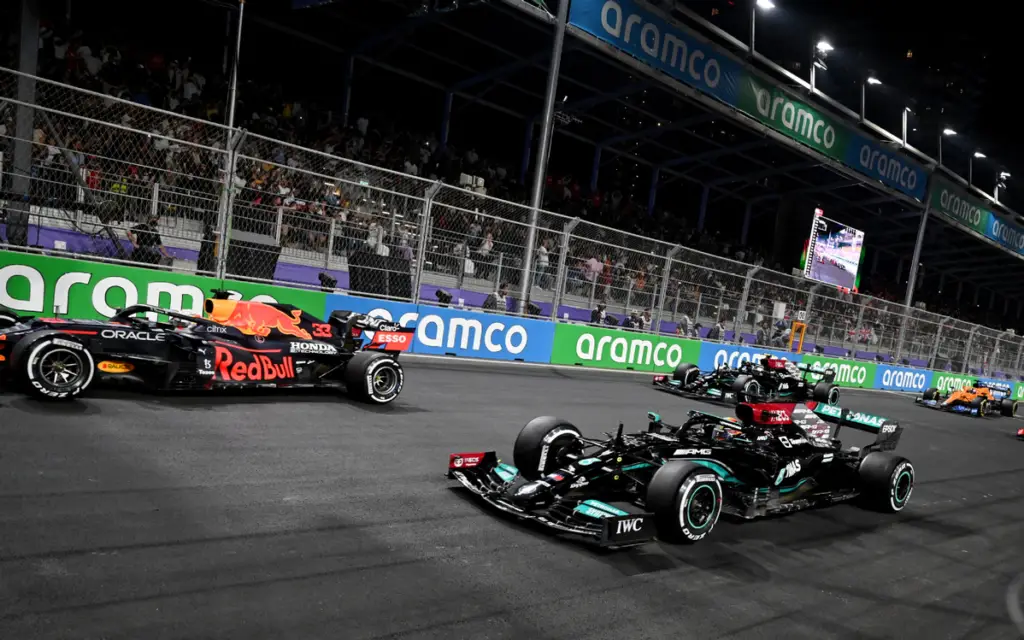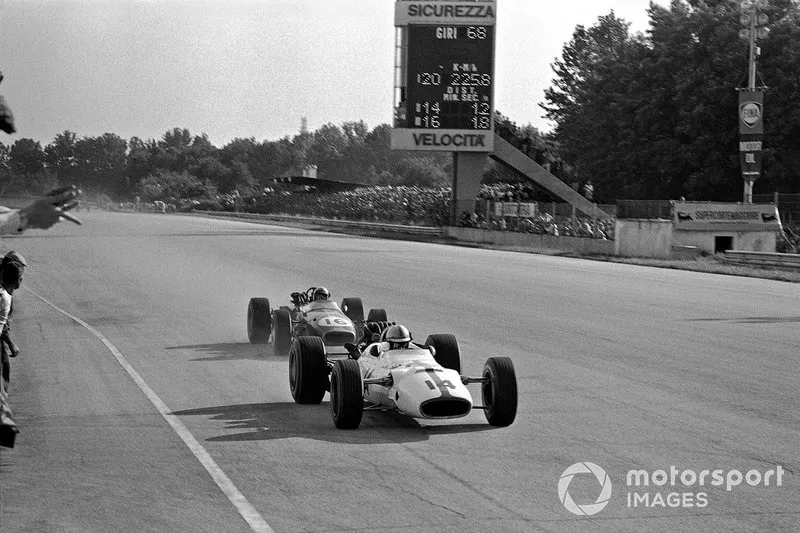Formula 1, the pinnacle of motorsport racing, is a sport where precision and speed are paramount. With cars racing at high speeds, the difference between winning and losing can be fractions of a second. This raises the question: can there be a tie in F1?
Although it is theoretically possible for two F1 drivers to finish a race at exactly the same time, the F1 regulations published by the FIA cover this eventuality. To find the driver with the most points, a standard series of processes are followed to find the winner.
This brings us to an intriguing question: Can there be a tie in F1? Let’s delve into the rules and historical precedents to understand the possibilities of a tie in various scenarios within F1.
Can An F1 Race End in A Tie?

The short answer is no. F1’s timing systems are incredibly precise, measuring down to the thousandth of a second. In the history of F1, no race has ever ended in a tie. The closest finish recorded was at the 1971 Italian Grand Prix. Peter Gethin beat Ronnie Peterson by just 0.01 seconds.
Even if two cars cross the finish line seemingly at the same time, the one with the fastest lap during the race will be declared the winner.
Articles for you to read
How Do the Stewards Break a Tie in F1
In the unlikely event that two drivers cross the finish line at the same time, the FIA has a system for determining the winner.
The driver with the fastest lap time wins the race. This rule ensures that there is always a clear winner.
What Happens if There is a Tie in F1 Qualifying?
Qualifying sessions determine the starting grid for the race, and precision timing is crucial here as well. If two drivers set identical lap times, the driver who recorded the time first is given the higher position on the starting grid.
This scenario is rare but has occurred, such as at the 1997 European Grand Prix, where three drivers set the same qualifying time.
What happens in F1 if there are two champions (with the same number of points) at the end of the season?

The FIA’s sporting regulations have a clear tie-breaking system for the championship standings. If drivers are tied on points, the number of wins is compared, followed by the number of second places, and so on, until a winner is determined.
- Most wins,
- Most 2nd,
- Most 3rd,
- Most 4th, etc.
They count back until one driver has more wins, 2nds, 3rds, 4th etc.
In 2007, Alonso and Hamilton tied on points and wins, but Hamilton’s five 2nd places to Alonso’s four 2nd places gave him the lead in the official championship standings.
This countback method ensures that there is a single champion at the end of the season.
Can The F1 Championship Have Joint Winners?
According to the FIA regulations, there cannot be joint winners in the championship.
The countback system is designed to break any ties, and there has never been a situation in F1 history where the countback system was unable to determine a single champion.
Every Race Is Important
The possibility of a tie in the championship standings underscores the importance of every race in the season.
Every position and point can be crucial in determining the champion, adding to the sport’s competitive intensity.
Has There Ever Been a Tie in F1?
While there has never been a tie at the end of the championship, there have been instances where drivers were tied on points during the season.
However, by the end of the season, the countback system or subsequent races have always produced a clear champion.
The 10 Closest Finishes in F1
F1 has seen some incredibly close finishes throughout its history. The 10 closest finishes have been moments of high drama, showcasing just how competitive the sport can be. These finishes are a testament to the precision of the timing systems and the skill of the drivers in the sport.
Tie in F1 – Italian Grand Prix, 1967

Before the era of aerodynamic wings and downforce, which create turbulent air that makes it hard for cars to follow each other closely, the Italian Grand Prix at Monza was more like a bike race.
Drivers would work together to slipstream, similar to cyclists in a peloton, attempting to pull ahead of the group. The 1967 race was celebrated as one of the most thrilling of that time.
However, Monza’s reputation for being tough on engines led to many cars dropping out, which scattered the groups throughout the race.
Tie in F1 – Austrian Grand Prix, 2002
With McLaren’s MP4-17 proving to be unreliable, Ferrari’s main opposition in the early stages of the season came from BMW Williams. Still, Michael Schumacher had won four out of the first five races of the season when the paddock arrived in Austria.
Teammate Rubens Barrichello took the pole and led virtually the entire race until being asked to relinquish his position and hand Schumacher the lead and the win. Barrichello initially argued but ultimately yielded to the team’s pressure.
He did hand Schumacher the win, but he did so ostensibly so there could be no doubt about what had transpired. He slowed down coming out of the final corner, with Schumacher edging ahead by 0.182 seconds.
Tie in F1 – Canadian Grand Prix, 2000
In a mixed-weather race at the Circuit Gilles Villeneuve, Schumacher began in the first position and kept his lead through two pit stops, the second of which was to switch to rain tires. Despite a minor detour off the track at Turn One, Schumacher maintained a comfortable lead over Barrichello.
However, as the rain got heavier, Barrichello started to catch up to the German. Near the end, Barrichello appeared faster than Schumacher, but Ferrari’s team orders required him to stay behind. The race concluded with Schumacher and Barrichello finishing almost simultaneously, only 0.174 seconds apart.
Tie in F1 – French Grand Prix, 1954
The 1954 French Grand Prix at Reims was influenced by team strategies during the formative years of the world championship.
This race marked the much-awaited first appearance of the Mercedes W196, which boasted a straight-8 fuel-injection engine and an aerodynamically efficient design that was well-suited for the fast circuit.
Tie in F1 – French Grand Prix, 1961

The 1961 French Grand Prix at Reims was a tight competition between two front-runners, but this time, it wasn’t affected by team orders.
Ferrari was anticipated to lead after performing well in previous races. Phil Hill, who was leading the championship, started strong but lost his chance after spinning out of the race.
Tie in F1 – Italian Grand Prix, 1969
The 1969 Italian Grand Prix is remembered as an iconic display of slipstreaming at the Monza circuit, often referred to as the “cathedral of speed.”
Although it wasn’t the tightest finish in history, the race is notable for its extremely close finish among the top four drivers.
Tie in F1 – Austrian Grand Prix, 1982
The 1982 Austrian Grand Prix at the Osterreichring was notable for being one of the first races where cars strategically stopped for fuel and tires. Nelson Piquet and Riccardo Patrese of the Brabham BMW team qualified in the lead and started the race with only half-full fuel tanks, planning for their groundbreaking pitstops.
However, despite the innovative strategy, both Brabham cars had to retire due to mechanical problems. This left Alain Prost of Renault in the lead until he also had to stop his car with only five laps remaining due to issues.
Tie in F1 – Spanish Grand Prix, 1986
The first-ever grand prix on the newly constructed Circuito de Jerez produced a humdinger of a race. Ayrton Senna converted his pole position into an early lead in the Lotus.
Nigel Mansell passed William’s teammate Nelson Piquet en started hounding the Brazilian around the twisty Spanish track. Mansell managed to pass Senna, who then returned the favor with an aggressive move.
That caused Mansell to also lose a position to Alain Prost in the McLaren, which prompted him to pit for new tires.
Tie in F1 – United States Grand Prix, 2002

By September 2002, when Formula 1 arrived at Indianapolis, Michael Schumacher had already clinched his fifth world title. However, the controversy surrounding the Austrian Grand Prix earlier that year, in which Schumacher’s teammate, Rubens Barrichello, was ordered to let Schumacher win, remained in people’s minds.
With the championship already decided, Barrichello was free to compete against Schumacher. Schumacher started from pole position and was leading, on track for his eleventh win of the season,
He unexpectedly slowed down on the main straight.
Barrichello, initially confused by Schumacher’s actions, hesitated but then passed him to take the win by a mere 0.011 seconds.
Tie in F1 – Italian Grand Prix, 1971

Monza is known for its high-speed excitement and tight competition. It upheld its reputation during the 1971 Italian Grand Prix.
It became famous for the closest finish in Formula 1 history.
Like in 1969, the race featured a leading group of four cars fiercely competing for the victory.
Conclusion
The structure of Formula 1’s rules and the precision of its timing technology make a tie in a race or championship practically impossible. Every lap and every race are critical, and the FIA has ensured that mechanisms exist to declare a definitive winner in every scenario. The thrill of F1 partly lies in these fine margins, where every second, or even thousandth of a second, counts.

